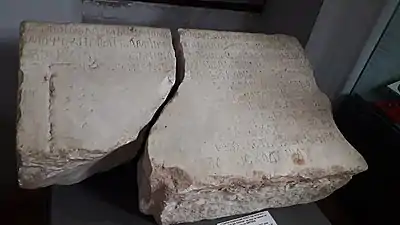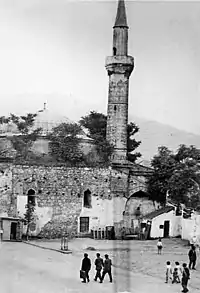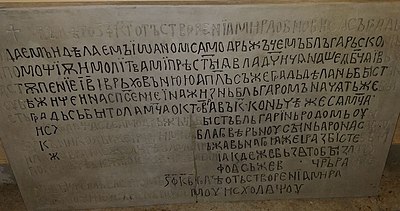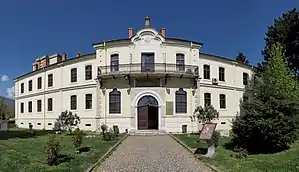
The Bitola inscription is a stone inscription from the First Bulgarian Empire written in the Old Church Slavonic language in the Cyrillic alphabet.[1] Currently, it is located at the Institute and Museum of Bitola, North Macedonia among the permanent exhibitions as a significant epigraphic monument, described as "a marble slab with Cyrillic letters of Ivan Vladislav from 1015/17".[2] In the final stages of the Byzantine conquest of Bulgaria Ivan Vladislav was able to renovate and strengthen his last fortification, commemorating his work with this elaborate inscription.[3] The inscription found in 1956 provided strong arguments supporting the Bulgarian character of Samuil's state, disputed by the Yugoslav scientists.[4] The mainstream academic view is that the inscription is an original artefact, made during the rule of Ivan Vladislav.[5]
History
Finding

The inscription was found in Bitola, SR Macedonia, in 1956 during the demolition of the Sungur Chaush-Bey mosque. The mosque was the first mosque that was built in Bitola, in 1435. It was located on the left bank of the River Dragor near the old Sheep Bazaar.[6] The stone inscription was found under the doorstep of the main entrance and it is possible that it was taken as a building material from the ruins of the medieval fortress. The medieval fortress was destroyed by the Ottomans during the conquest of the town in 1385. According to the inscription, the fortress of Bitola was reconstructed on older foundations in the period between the autumn of 1015 and the spring of 1016. At that time Bitola was a capital and central military base for the First Bulgarian Empire. After the death of John Vladislav in the Battle of Dyrrhachium in 1018, the local boyars surrendered the town to the Byzantine emperor Basil II. This act saved the fortress from destruction. The old fortress was located most likely on the place of the today Ottoman Bedesten of Bitola.[7]
Decryption
After the inscription was found, information about the plate was immediately announced in the city. It was brought to Bulgaria with the help of the local activist Pande Eftimov. A fellow told him that he had found a stone inscription while working on a new building and that the word "Bulgarians" was on it.[8] The following morning, they went to the building where Eftimov took a number of photographs which were later given to the Bulgarian embassy in Belgrade.[9] His photos were sent to diplomatic channels in Bulgaria and were classified. In 1959, the Bulgarian journalist Georgi Kaloyanov sent his own photos of the inscription to the Bulgarian scientist Aleksandar Burmov, who published them in Plamak magazine. Meanwhile, the plate was transported to the local museum repository. At that time, Bulgaria avoided publicising this information as Belgrade and Moscow had significantly improved their relations after the Tito–Stalin split in 1948. However, after 1963, the official authorities openly began criticizing the Bulgarian position on the Macedonian Question, and thus changed its position.
In 1966, a new report on the inscription by Vladimir Moshin, a Russian emigrant living in Yugoslavia, was published.[10] As a result Bulgarian scientists Yordan Zaimov and his wife, Vasilka Tapkova-Zaimova, travelled to Bitola in 1968.[9] At the Bitola Museum, they made a secret rubbing from the inscription.[11] Zaimova claims that no one stopped them from working on the plate in Bitola.[9] As such, they deciphered the text according to their own interpretation of it, which was published by the Bulgarian Academy of Sciences in 1970.[12] The stone was locked away in the same year and a big Bulgarian-Yugoslav political scandal arose. The museum director was fired for letting such a mistake happen.[13] The Macedonian researcher Ugrinova-Skalovska published her translation of the inscription in 1975.
Text
In its current state, the following text is visible on the stone:[14]
1. ....аемъ и дѣлаемъ Їѡаном самодрьжъцемъ блъгарьско...
2. ...омощїѫ и молїтвамї прѣс͠тыѧ владч҃ицѧ нашеѧ Б͠цѧ ї в...
3. ...ѫпенїе І҃В҃ і врьховънюю апл҃ъ съ же градь дѣлань быст...
4. ...ѣж.... и на спс҃енѥ ї на жизнь бльгаромъ начѧть же і...
5. ...... градь с.....и..ола м͠ца ок...вра въ К҃. коньчѣ же сѧ м͠ца...
6. ...ис.................................................быстъ бльгарїнь родомь ѹ...
7. ...к..................................................благовѣрьнѹ сынь Арона С.....
8. ......................................................рьжавьнаго ꙗже i разбїсте .....
9. .......................................................лїа кде же вьзꙙто бы зл.....
10. ....................................................фоꙙ съ же в... цр҃ь ра.....
11. ....................................................в.. лѣ... оть створ...а мира
12. ........................................................мѹ исходꙙщѹ.
Text reconstructions

Part of the text is missing, as the inscription was used as a step of the Sungur Chaush-Bey mosque and therefore the first row was destroyed. The reconstruction of the Macedonian scientist prof. Radmila Ugrinova-Skalovska[15] is very similar to the reconstruction made by the Yugoslav/Russian researcher Vladimir Moshin (1894–1987),[16] and the Bulgarian Prof. Yordan Zaimov (1921–1987). With some conjectures made by Zaimov to reconstruct the damaged parts, their version of the text reads as follows:[17]
† Въ лѣто Ѕ҃Ф҃К҃Г҃ отъ створенїа мира обнови сѧ съ градь зидаемъ и дѣлаемъ Їѡаном самодрьжъцемъ блъгарьскомь и помощїѫ и молїтвамї прѣс͠тыѧ владч҃ицѧ нашеѧ Б͠цѧ ї въз()стѫпенїе І҃В҃ і врьховънюю апл҃ъ съ же градь дѣлань бысть на ѹбѣжище и на спс҃енѥ ї на жизнь бльгаромъ начѧть же бысть градь сь Битола м͠ца окто͠вра въ К҃. коньчѣ же сѧ м͠ца ... исходѧща съ самодрьжъць быстъ бльгарїнь родомь ѹнѹкъ Николы же ї Риѱимиѧ благовѣрьнѹ сынь Арона Самоила же брата сѫща ц͠рѣ самодрьжавьнаго ꙗже i разбїсте въ Щїпонѣ грьчьскѫ воїскѫ цр҃ѣ Васїлїа кде же вьзꙙто бы злато ... фоꙙ съжев ... цр҃ь разбїень бы цре҃мь Васїлїемь Ѕ҃Ф҃К҃В҃ г. лтѣ оть створенїѧ мира въ Ключи ї ѹсъпе лѣтѹ семѹ исходꙙщѹ
In the year 6523 since the creation of the world [1015/1016? CE], this fortress, built and made by Ivan, Tsar of Bulgaria, was renewed with the help and the prayers of Our Most Holy Lady and through the intercession of her twelve supreme Apostles. The fortress was built as a haven and for the salvation of the lives of the Bulgarians. The work on the fortress of Bitola commenced on the twentieth day of October and ended on the [...] This Tsar was Bulgarian by birth, grandson of the pious Nikola and Ripsimia, son of Aaron, who was brother of Samuil, Tsar of Bulgaria, the two who routed the Greek army of Emperor Basil II at Stipon where gold was taken [...] and in [...] this Tsar was defeated by Emperor Basil in 6522 (1014) since the creation of the world in Klyuch and died at the end of the summer.
Alternative views
American linguist Horace Lunt promoted the idea that the plate might have been made during the reign of Ivan Asen II ca. 1230, or that the inscription might have been composed of two pieces, lettered at different times.[18][19] His views were based on the photos, as well as the latex mold reprint of the inscription made by the professor of classical philology Ihor Ševčenko of Dumbarton Oaks, unlike the approach of Zaimov, who created the re-print copy of the leftover text with special paper and water, when he visited Bitola in 1968.[9] Some modern researchers from North Macedonia have denied the dating of the inscription, claiming the existence of the contemporary Bulgarian identification was impossible, whilst also disputing the original size of the inscription, the titles of the rulers inside the text, the specific way of invoking the saints' help, its authenticity, etc.[20][21]
On the 23rd International Congress of Byzantine Studies in 2016, archaeologists Elena Kostić and Georgios Velenis—who worked on the field with the plate itself—reported that on the very top part of the plate, there were holes and channels to fit Π-shaped metal joints.[22] Therefore, the plate could not have the 13th row and that it was more likely that the plate was part of a much older object from the Roman period. Based on the form of the used letters, they gave the date 1202–1203, when Kaloyan was the Bulgarian ruler.[23] Nevertheless both researchers have summarized that most researchers who studied the inscription believe that the inscription is the last written source of the First Bulgarian Empire with an accurate dating, some others argued it is from the 13th century and only a single study proclaimed it as a forgery.[22]
Criticism
The few researchers presenting the thesis that the inscription was from the time of the Second Bulgarian Empire (based on one unreadable date in the first case, and on the specific form of the letters in the second) do not give an explanation of where the Bulgarian ruler at that time had detailed information about some events from the end of the First Bulgarian Empire. It is about the kinship of the Comitopuli, as well as some historical battles. It is not clear why this Bulgarian ruler called Ivan, who according to them was not Ivan Vladislav, claimed to be the grandson of Comita Nikola and Ripsimia of Armenia, and son of Aron of Bulgaria, who was Samuel of Bulgaria's brother.[24]
Legacy

The inscription confirms that Tsar Samuel and his successors considered their state Bulgarian,[25] as well as revealing that the Cometopuli had an incipient Bulgarian consciousness.[26] The proclamation announced the first use of the Slavic title "samodŭrzhets", meaning "autocrat".[27]
The name of the city of Bitola is mentioned for the first time in the inscription.[28] The Bitola inscription is a constructional one – it announces the reconstruction of a fortress. The text contains valuable information about the genealogy of the ruler Ivan. It becomes clear from it, that this ruler was the grandson of Nicholas and Ripsimia and the son of Aaron, Samuel's brother. The victory of the Bulgarians over the Byzantine emperor Basil II at the Trayanovi Vrata pass in 986, and the defeat of Samuel in the battle near the village of Klyuch in 1014 are also mentioned.[29] The inscription indicates that in the 10th and 11th centuries, the patron saints of Bitola were the Holy Virgin and the Twelve Apostles.[30]
After the collapse of Yugoslavia, the stone was re-exposed in the medieval section of the Bitola museum, but without any explanation about its text.[31] In 2006, the inscription was subject to controversy in the Republic of Macedonia (now North Macedonia) when the French consulate in Bitola sponsored and prepared a tourist catalogue of the town. It was printed with the entire text of the inscription on its front cover, with the word "Bulgarian" clearly visible on it. News about that had spread prior to the official presentation of the catalogue and was a cause for confusion among the officials of the Bitola municipality. The French consulate was warned and the printing of the new catalogue was stopped, and the photo on the cover was changed.[32] In 2021, a Bulgarian television team made an attempt to shoot the artefact and make a film about it. After several months of waiting and the refusal of the local authorities, the team complained to the Ministry of Foreign Affairs in Sofia. A protest note was sent from there to Skopje, after which the journalists received permission to work in Bitola.[33]
Footnotes
- ↑ Vasilka Tăpkova-Zaimova, Bulgarians by Birth: The Comitopuls, Emperor Samuel and their Successors According to Historical Sources and the Historiographic Tradition, East Central and Eastern Europe in the Middle Ages, 450–1450, BRILL, 2018, ISBN 9004352996, pp. 17–18.
- ↑ "Among the most significant findings of this period presented in the permanent exhibition is the epigraphic monument a marble slab with Cyrillic letters of Jovan Vladislav from 1015/17." The official site of the Institute for preservation of monuments of culture, Museum and Gallery Bitola
- ↑ Jonathan Shepard, Equilibrium to Expansion (886–1025); pp 493-536; from Part II - The Middle Empire c. 700–1204 in The Cambridge History of the Byzantine Empire C.500-1492 (2008) Cambridge University Press, p. 529, ISBN 0521832314.
- ↑ Roumen Daskalov (2021) Master Narratives of the Middle Ages in Bulgaria, East Central and Eastern Europe in the Middle Ages, 450-1450, BRILL, pp. 226-227, ISBN 9004464875.
- ↑
- Historical Dictionary of the Republic of Macedonia, Dimitar Bechev, Scarecrow Press, 2009 ISBN 0810855658, p. 195.
- Reuter, Timothy, ed. (2000). The New Cambridge Medieval History, Volume 3, c.900–c.1024. Cambridge: Cambridge University Press. p. 600. ISBN 978-1-13905572-7.
- Mango, Cyril ed. (2002). The Oxford History of Byzantium. OUP Oxford. ISBN 0-19-814098-3, p. 238.
- The legend of Basil the Bulgar-slayer, Paul Stephenson, Cambridge University Press, 2003, ISBN 0-521-81530-4, pp. 29–30.
- Southeastern Europe in the Middle Ages, 500–1250, Cambridge medieval textbooks, Florin Curta, Cambridge University Press, 2006, ISBN 0-521-81539-8, p. 246.
- Basil II and the governance of Empire (976–1025), Oxford studies in Byzantium, Catherine Holmes, Oxford University Press, 2005, ISBN 0-19-927968-3, pp. 56–57.
- Das makedonische Jahrhundert: von den Anfängen der nationalrevolutionären Bewegung zum Abkommen von Ohrid 1893–2001; ausgewählte Aufsätze, Stefan Troebst, Oldenbourg Wissenschaftsverlag, 2007, ISBN 3-486-58050-7, S. 414.
- Krieg und Kriegführung in Byzanz: Die Kriege Kaiser Basileios II. Gegen die Bulgaren (976–1019), Paul Meinrad Strässle, Böhlau Verlag Köln Weimar 2006, ISBN 341217405X, p. 172.
- Византийский временник, Институт истории (Академия наук СССР), Институт славяноведения и балканистики (Академия наук СССР), Институт всеобщей истории (Российская академия наук) Изд-во Академии наук СССР, 1973, стр. 266.
- Bŭlgarski ezik, Institut za bŭlgarski ezik (Bŭlgarska akademiia na naukite) 1981, p. 372.
- Срђан Пириватрић, „Самуилова држава. Обим и карактер", Византолошки институт Српске академије науке и уметности, посебна издања књига 21, Београд, 1997, стр. 183.
- Ivan Vladislav. In Prosopographie der mittelbyzantinischen Zeit (2013). Berlin, Boston: De Gruyter. Retrieved February 19, 2019.
- Иван Микулчиќ, Средновековни градови и тврдини во Македонија. (Македонска академија на науките и уметностите — Скопје, 1996), стр. 140–141.
- ↑ Present location opposite the trade center Javor on the left side of the street Philip II of Macedonia. For more see: Chaush-Bey Mosque – one of the oldest mosques in the Balkans (demolished in 1956), on Bitola.info
- ↑ Robert Mihajlovski, Circulation of Byzantine lead seals as a contribution to the location of medieval Bitola on International Symposium of Byzantologists, Nis and Byzantyum XVIII, "800 years since the Аutocephaly of the Serbian Church (1219–2019): Church, Politics and Art in Byzantium and neighboring countries" pp. 573 – 588; 574.
- ↑ Николова, В., Куманов, М., България. Кратък исторически справочник, том 3, стр. 59.
- 1 2 3 4 "Камъкът на страха, филм на Коста Филипов". Archived from the original on July 24, 2016. Retrieved February 19, 2019.
- ↑ Битољска плоча из 1017 године. Македонски jазик, XVII, 1966, 51–61.
- ↑ сп. Факел. Как Йордан Заимов възстанови Битолския надпис на Иван Владислав? 3 декември 2013, автор: Василка Тъпкова-Заимова.
- ↑ „Битолския надпис на Иван Владислав, самодържец български. Старобългарски паметник от 1015 – 1016 година.", БАН. 1970 г.
- ↑ Камъкът на страха – филм на Коста Филипов – БНТ.
- ↑ Stojkov, Stojko (2014). Битолската плоча. Goce Delčev University. p. 80. Retrieved November 18, 2022.
- ↑ Угриновска-Скаловска, Радмила. Записи и летописи. Maкедонска книга, Скопје 1975. стр. 43–44.
- ↑ Мошин, Владимир. Битољска плоча из 1017. год. // Македонски jазик, XVII, 1966, с. 51–61
- ↑ Заимов, Йордан. Битолският надпис на цар Иван Владислав, самодържец български. Епиграфско изследване, София 1970, [review of Zaimov]. Slavic Review 31: 499.
- ↑ Horace Lunt, Review of "Bitolski Nadpis na Ivan Vladislav Samodurzhets Bulgarski: Starobulgarski Pametnik ot 1015–1016 Godina" by Iordan Zaimov and Vasilka Zaimova, Slavic Review, vol. 31, no. 2 (Jun. 1972), p. 499
- ↑ Robert Mathiesen, The Importance of the Bitola Inscription for Cyrillic Paleography, The Slavic and East European Journal, 21, Bloomington, 1977, 1, pp. 1–2.
- ↑ Mitko B. Panov, The Blinded State: Historiographic Debates about Samuel Cometopoulos and His State (10th–11th Century); BRILL, 2019, ISBN 900439429X, p. 74.
- ↑ Стојков, Стојко (2014) Битолската плоча – дилеми и интерпретации. Во: Самуиловата држава во историската, воено-политичката, духовната и културната традиција на Македонија, 24–26 октомври 2014, Струмица, Македонија.
- 1 2 Georgios Velenis, Elena Kostić (2016). Proceedings of the 23rd International Congress of Byzantine Studies. Belgrade: The Serbian National Committee of AIEB and the contributors 2016. p. 128. ISBN 978-86-83883-23-3.
- ↑ Georgios Velenis, Elena Kostić (2017). Texts, Inscriptions, Images: The Issue of the Pre-Dated Inscriptions in Contrary with the Falsified. The Cyrillic Inscription from Edessa. Sofia: Институт за изследване на изкуствата, БАН. p. 117. ISBN 978-954-8594-65-3.
- ↑ Georgi Mitrinov, Contributions of the Sudzhov family to the preservation of Bulgarian cultural and historic heritage in Vardar Macedonia, Sofia University St. Kliment Ohridski, language; Bulgarian, Journal: Българска реч. 2016, Issue No: 2, pp. 104–112.
- ↑ Dennis P. Hupchick, The Bulgarian-Byzantine Wars for Early Medieval Balkan Hegemony: Silver-Lined Skulls and Blinded Armies, Springer, 2017, ISBN 3319562061, p. 314.
- ↑ Michael Palairet, Macedonia: A Voyage through History, Volume 1, Cambridge Scholars Publishing, 2016, ISBN 1443888435, p. 245.
- ↑ Ivan Biliarsky, Word and Power in Mediaeval Bulgaria, Volume 14 of East Central and Eastern Europe in the Middle Ages, 450–1450, BRILL, 2011, ISBN 9004191453, p. 215.
- ↑ Room, Adrian, Placenames of the world: origins and meanings of the names for 6,600 countries, cities, territories, natural features, and historic sites, Jefferson, N.C.: McFarland & Company, ISBN 0-7864-2248-3, 2006, p. 60.
- ↑ Деница Петрова, Битолски надпис на Иван Владислав. Scripta Bulgariaca.
- ↑ Robert Mihajlovski (2021) The Religious and Cultural Landscape of Ottoman Manastır. Handbook of Oriental Studies, BRILL, p. 18; ISBN 900446526X.
- ↑ J. Pettifer ed., The New Macedonian Question, St Antony's Series, Springer, 1999, ISBN 0230535798, p. 75.
- ↑ Исправена печатарска грешка, Битола за малку ќе се претставуваше како бугарска. Дневник-online, 2006.Archived February 24, 2012, at the Wayback Machine
- ↑ Битолският надпис в bTV Репортерите на 19 и 20 юни. 17.06.2021, bTV.
References
- Божилов, Иван. Битолски надпис на Иван Владислав // Кирило-методиевска енциклопедия, т. І, София, 1985, с. 196–198. (in Bulgarian)
- Бурмов, Александър. Новонамерен старобългарски надпис в НР Македония // сп. Пламък, 3, София, 1959, 10, с. 84–86. (in Bulgarian)
- Заимов, Йордан. Битолски надпис на Иван Владислав, старобългарски паметник от 1015–1016 // София, 1969. (in Bulgarian)
- Заимов, Йордан. Битолският надпис на цар Иван Владислав, самодържец български. Епиграфско изследване // София, 1970. (in Bulgarian)
- Заимов, Йордан. Битольская надпись болгарского самодержца Ивана Владислава, 1015–1016 // Вопросы языкознания, 28, Москва, 1969, 6, с. 123–133. (in Russian)
- Мошин, Владимир. Битољска плоча из 1017. год. // Македонски jазик, XVII, Скопје, 1966, с. 51–61 (in Macedonian)
- Мошин, Владимир. Уште за битолската плоча од 1017 година // Историја, 7, Скопје, 1971, 2, с. 255–257 (in Macedonian)
- Томовић, Г. Морфологиjа ћирилских натписа на Балкану // Историјски институт, Посебна издања, 16, Скопје, 1974, с. 33. (in Serbian)
- Џорђић, Петар. Историја српске ћирилице // Београд, 1990, с. 451–468. (in Serbian)
- Mathiesen, R. The Importance of the Bitola Inscription for Cyrilic Paleography // The Slavic and East European Journal, 21, Bloomington, 1977, 1, pp. 1–2.
- Угринова-Скаловска, Радмила. Записи и летописи // Скопје, 1975, 43–44. (in Macedonian)
- Lunt, Horace. On dating Old Church Slavonic bible manuscripts. // A. A. Barentsen, M. G. M. Tielemans, R. Sprenger (eds.), South Slavic and Balkan linguistics, Rodopi, 1982, p. 230.
- Georgios Velenis, Elena Kostić, (2017). Texts, Inscriptions, Images: The Issue of the Pre-Dated Inscriptions in Contrary with the Falsified. The Cyrillic Inscription from Edessa.